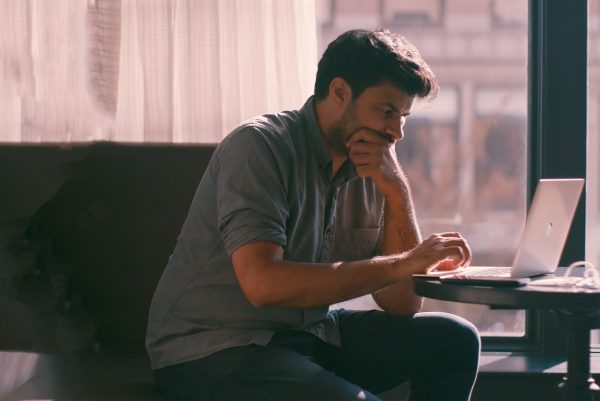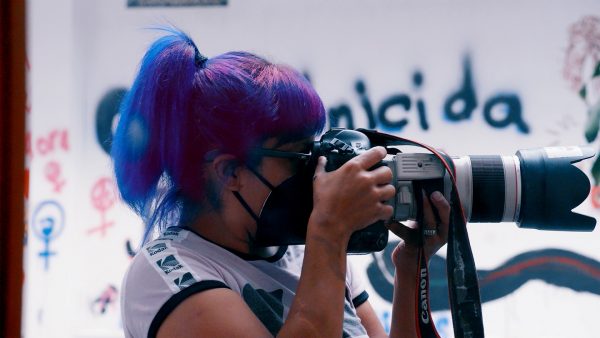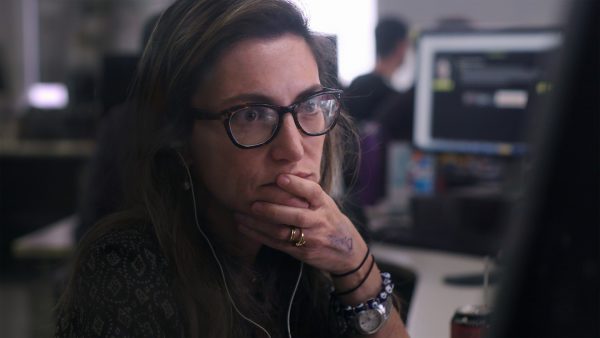‘Endangered’ pinpoints threats to our freedoms

“Endangered” (2022). Cast: Sáshenka Gutiérrez, Carl Juste, Oliver Laughland, Patrícia Campos Mello, Joel Simon, Enrique Tarrio. Archive Footage: Omar Jimenez. Directors: Heidi Ewing and Rachel Grady. Web site. Trailer.
The freedoms that a democracy enjoys depend heavily on having watchdogs on duty to protect and preserve those precious liberties. And, in many instances, that responsibility typically falls to the press, particularly one that has been imbued with the ability to operate freely and without interference. This is most notably true in the US, where the First Amendment to the Constitution guarantees this right. It’s a principle that has consequently inspired media organizations in other countries, too, especially those located in nations where those outlets have had to struggle to do their jobs under the thumb of severe government scrutiny and restrictions. But now this institution has increasingly come under fire, threatening its existence and, by extension, much, much more, as the incisive new HBO documentary “Endangered” so poignantly illustrates.
Because of its sacred charge, journalism has long been regarded as a noble profession, particularly when its practitioners have performed stellar jobs in uncovering crime and corruption that threaten the public’s well-being, as was the case, for example, with the Washington Post investigation in exposing the Watergate scandal. It’s a profession that has typically been regarded in high esteem, especially for those who toil away at it for underwhelming recognition and often-substandard pay. But those who do this work generally feel compelled to forge ahead with it in order to get to the truth, a passion that transcends these measures of worth.
In recent years, however, that has all begun to change, for a variety of reasons. Declining revenues and the rising costs of doing business have caused many media outlets (especially newspapers) to close down or consolidate, leaving the public with fewer (or sometimes even no) such organizations in their geographic areas, as happened, for instance, in Youngstown, OH, with the closure of its daily newspaper, The Youngstown Vindicator. And, with fewer sources of news and information overall, that has meant less diversity and breadth in the coverage of everyday events, with some stories going completely unaddressed and others being presented with decidedly singular perspectives. Some media organizations have even pounced on these conditions as an opportunity to tinge their reporting with their own particular slants, be they left-leaning or right-wing, thereby intentionally skewing the principle of objectivity that’s supposed to be the media’s guiding mantra. This, in turn, has led to the proliferation of pontificating and even so-called “fake news.” It’s left the public increasingly wondering who to trust.
Given this shift, journalists are increasingly no longer looked upon in the same respected light that they once were. This has been exacerbated by the rampant polarization that has been simultaneously occurring in society at large, with many in the public gravitating to support media outlets that agree with their point of view and vociferously shunning those that do not. It’s as if the media are prompting the public to rally around those organizations that serve as echo chambers for their points of view in blind disregard for the accuracy of what’s being reported. This, needless to say, is not good for democracy.

“Endangered” shines a bright light on these troubling developments. In addition, it shows the increasingly difficult conditions under which journalists have been forced to work, including genuine threats to their livelihoods and personal safety. Public opinion of reporters has noticeably eroded, and many have faced increased harassment from authorities, as seen in archive footage from the on-air arrest of CNN journalist Omar Jimenez, who was escorted away by police simply for doing his job in covering a public protest. So much for the First Amendment.
The resources made available to journalists to do their work have also been scaled back. For example, photographer Carl Juste and his peers at The Miami Herald have had to learn how to get along without access to a news room, a significant adjustment for a major daily newspaper such as this. Imagine trying to do your job without a central location to confer with fellow professionals on matters essential to its execution, especially something as critical as getting out the news. Working remotely is one thing, as the post-pandemic world has shown us, but collaborating on this kind of team effort without the benefit of a central resource hub is something else entirely.
The decline in respect for reporters has also made it more difficult for journalists to cover their assignments. Sources such as government officials have resorted to practices like answering the questions they want to answer rather than answering the questions they’ve been asked, if not completely ignoring such inquiries entirely, an experience Oliver Laughland of the British newspaper The Guardian has undergone in his coverage of American politics. Such tactics aren’t exactly new, but they have become standard operating procedure to such a degree these days that it’s hard not only to get to the truth, but even to get to the gatekeepers of it.
These challenges have had a major impact on the coverage of some of the major news stories of recent years, as documented by frontline footage of these events, some of which has been incorporated in the film. Reporting on incidents like Black Lives Matter protests in response to the George Floyd killing, the handling of the COVID pandemic, the 2020 US presidential election and the January 6, 2021 storming of the US Capitol has routinely been hampered by the presence of defiant anti-press demonstrators, aggressive special police forces, and extremist groups like the Proud Boys and their incendiary chairman, Enrique Tarrio. It’s almost enough to make the average citizen wonder why anyone would want to engage in a seemingly insane line of work like this.

These issues are by no means limited to the US, either. Such hindrances have long been in place in other countries, but the impediments on what journalists in those nations can do have been skyrocketing, with harassment and questionable detention becoming the norm for silencing them. Death threats, for example, have become routine against Mexican journalists like photographer Sáshenka Gutiérrez of the Spanish news organization Agencia EFE, who has been courageously covering protests about the country’s spiraling violence against women. Elsewhere, politicians like Brazilian President Jair Bolsonaro have resorted to blatant retribution and outright libel to discredit reporters like Patrícia Campos Mello of the São Paolo newspaper Folha de S.Paolo for her scathing coverage of his corrupt campaign for office.
Such developments have made the work of activist organizations like the Committee to Protect Journalists (CPJ) that much harder. In daily phone conferences with reporters from around the world, from India to South Africa and everywhere in between, the organization has learned of growing atrocities committed against journalists. However, as now-former CPJ director Joel Simon explains in the film, these incidents reflect the need to remain diligent in the face of such outrageous tragedies. If we fail to act in the face of such growing violence and intimidation, it’s more than just journalists who stand to lose.
What’s perhaps most important in this is what we as a society have come to believe about the nature of the media, for our beliefs shape what unfolds, thanks to the conscious creation process, the philosophy that maintains the power of our thoughts, beliefs and intents determines what ultimately manifests. This raises some important questions, such as how much value do we place on the continued existence of an unfettered, objective press? Do we really need it as a channel for covering stories that have meaningful impact on our daily lives and the health of our economics, politics and culture? Or is it something to which we devote little thought, perceiving it as merely an outlet for sports scores, weather forecasts and celebrity gossip? Think of what kind of world we would have if we believe in that last question. Where would our democracy be then?
Then there’s the question of media bias, another area affected by the impact of our beliefs. Do we really believe, for example, that the press should be nothing more than a source of parroting what we already think? Or do we want a fair and impartial institution that’s going to enlighten us to what we don’t know – and that could potentially affect us in negative ways? Are we truly that unconcerned and apathetic?

Bias also raises the matter of sensationalism and tabloidization, qualities that have been increasingly infiltrating the media for several decades, a topic that, unfortunately, is touched upon only by way of implication in the film. These aspects of the media shouldn’t be overlooked, however, as they, too, are driven by the beliefs we collectively hold about what we expect out of the press. In many ways, these characteristics have arisen out of our desire for media that reflect our views, again often of a polarized nature. The trumped-up dramatics associated with sensationalism and tabloidization are designed to get our attention and draw readers, listeners or viewers to those outlets that embody the exaggerated viewpoints they hold. And it’s another regrettable development in the evolution of the press as it has turned up the shrillness factor in the reporting of the news (if it can even be called that any more). The result is a loss of a reasoned perspective, something else that threatens the preservation of a fair, free, objective press (and, potentially, the freedoms it’s meant to help protect).
“Endangered” primarily focuses on what’s been happening (and likely could happen) in the mainstream press, a longstanding sizable segment of the media community. It depicts the efforts that such outlets have invested in covering the aforementioned major news stories, journalistic undertakings that chronicle the work of reporters who are still genuinely committed to doing their jobs in the time-honored tradition that has long characterized this institution. It’s indeed gratifying to see the film incorporate such material, for it provides a much-needed sense of balance given the increasing bashing that the mainstream press has been subjected to in recent years (and, in some cases, deservedly so, especially in instances where some media outlets have given in to sensationalism and tabloidization).
The news stories that the film has chosen to focus on generally show sincere efforts by the mainstream press in trying to cover them fairly, professionally and responsibly, though I feel that these media outlets got something of a pass when it comes to their reporting on the COVID crisis. What’s shown of that coverage here illustrates the same kind of sincere commitment that was employed in the reporting of the other news stories. But, sadly, the picture largely ignores much of what I believe was exaggerated, fear-mongering coverage that the mainstream press engaged in when reporting on the pandemic, one of the film’s disappointing aspects, in my view. Moreover, that oversight, from my perspective, illustrates just how insidious some of these emerging developments in the journalism community can be. If something so glaring as this can be essentially disregarded, then that means we’re losing sight of what’s going on in the media. The failure to address changes like these could potentially carry serious implications for us all – and not just in the press, but also in society at large.

Considering the immense scope of this subject, it’s admittedly difficult to devote coverage to all of the issues involved in a single film. Among those that receive little or no attention are the rise of corporate influence and agendas on media organizations, the impact of consolidation of media outlets in fewer hands, the rise of alternative media (and the dual-edged sword it represents), and the emergence of media celebrities versus true journalists. Like the aforementioned issues, these developments all have potential impact on what is and what might be happening to the press. They merit scrutiny, not only in terms of what manifests, but also in terms of what we expect from the media, something that’s a direct result of what we believe the press is supposed to do in providing us with information and in living up to its responsibility as a valiant guardian of the liberties of our society. How will it turn out? A lot depends on us and the value we place on these considerations. To see what transpires, stay tuned – while we still have the opportunity to do so.
Being a journalist isn’t what it used to be, as directors Heidi Ewing and Rachel Grady clearly show in this compelling new documentary. The filmmakers present an unflinching look at what media professionals are increasingly up against in simply doing their jobs and what we all stand to lose if the Fourth Estate is allowed to be further compromised. The compilation of frontline footage of major news stories and the experiences of the four featured journalists paint a distressing picture for the future of this once-noble profession, something not to be overlooked or ignored. To be sure, some of the material could stand to be better organized and more fully developed, and the film’s use of split screen imagery definitely should have been scaled back. However, as a college-trained journalist who worked in the field for years, I find it sad to see what’s become of the profession I so loved – and disheartening to witness how little most of society cares about its decline. Let’s hope this film educates us to this issue so that we don’t live to regret it. The film is available for streaming on HBOMAX and other online platforms.
A longtime fellow journalist and friend of mine wryly observed not long ago that “We no longer have journalism anymore; we have ‘media’ instead.” How profound and incisive those words have unfortunately become. In a society where newspapers, for instance, have come to be regarded more for their value as packing material than as sources of vital news and information, it’s troubling to think about where we might well be headed. Indeed, I’d assert that the value of a free and fair press is essential to the health and well-being of society. But I’d like to take things a step further. While there should be no doubt that the media have an obligation to fulfill the public’s right to know, there should be a corresponding responsibility on the part of the public to ensure this institution’s continued right to exist. To do any less runs the risk of following a truly perilous course, one from which there may be no return.
Copyright © 2022, by Brent Marchant. All rights reserved.



